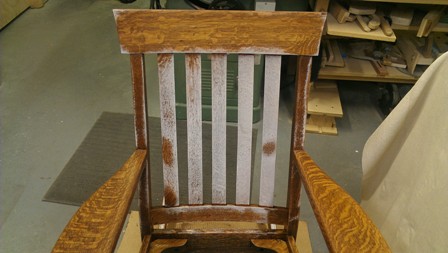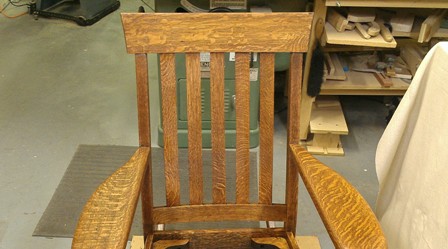Although it may look like frost, the white in the photo below is actually an example of shellac blushing. Blushing is caused by moisture that gets trapped in the finish when the top layer of the finish dries before the moisture has a chance to escape. It typically occurs when the humidity is high or there’s too much water in the alcohol that’s used to thin the shellac. As the alcohol dries, it cools the finished surface, facilitating the condensation of moisture on the finish.

Shellac blushing formed by trapped moisture
In this case, the blushing occurred after spraying on a coat of 2# cut blond shellac with the work piece outside on a late Fall day. It was relatively warm that day but apparently also fairly humid. I applied the shellac late in the day, about an hour before sunset, so the relative humidity was undoubtedly elevated because the temperature was dropping.
The blushing was mostly confined to the front side of the chair back slats. I initially applied a light coat to the slats and then tilted the chair backwards to spray the underside. I then applied a second light coat to the slats with them now facing upward. During the interval between coats, moisture apparently began forming on the surface of the slats which was then trapped in the finish when the second coat was applied. Within minutes of bringing the chair back inside, the blushing started to form, becoming whiter and whiter. Within 15 minutes, the grain on the slats was totally obscured by the blushing. It truly did appear to be a thick coating of frost.

Blushing removed after wiping with alcohol dampened rag
Fortunately, it’s fairly easily to fix shellac blushing. Using a cotton rag dampened with alcohol, I just wiped over the affected areas which dissolves enough of the finish to allow the trapped moisture to escape. Within seconds, the blushing was gone and the finish looked normal, although slightly duller (less glossy) than surrounding areas. The dullness disappeared once another coat of shellac was applied.
Lesson learned: Don’t apply shellac when the humidity is high.

